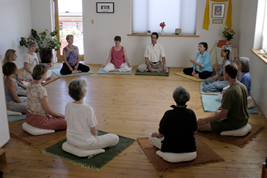 Check out last week’s blog –
Check out last week’s blog –
What Causes Suffering? pt.1
This morning as I dressed to meet my friend for coffee, my husband plugged in the vacuum and started vacuuming the upstairs rugs. “Lucky,” so many of my friends would say. Instead of feeling lucky, however, I felt guilty.
“I will do that,” I told him. “You don’t have to.”
“When will you have time?” he responded. “I don’t mind.”
I realized he was right, but even as I sit and write this, I still feel disappointed I had not taken care of the vacuuming, especially as my husband does many chores to maintain our home.
The unease I feel comes from two sources. The first, the comparisons I make with other women who are far more attentive housekeepers than I. They maintain homes appearing orderly, vacuumed, and elegantly decorated. While my unease as a housekeeper does not qualify as “suffering,” my thinking leads me to feel “inadequate” when the subject of housekeeping comes up. I start to think about the bathroom needing cleaning, the rug needing vacuuming, or the cobwebs to be dusted from the top kitchen shelf.
But, on the positive side, I am able to recognize my thinking and assumptions as avidya (lack of understanding, misapprehension), and specifically as that branch of avidya called asmita. Asmita or ego can also be described as “I-am-ness.” When asmita rules the mind we have a distorted view of ourselves. We think we are better than others or not as good – superior or inferior, both of which are avidya.
In our own lives, each of us has a set of descriptions we use when asked about our background. “I am a mother.” “I am a doctor.” “I am a yoga student.” “I am a diabetic.” “I am a Methodist.” “I am an American.” “I am a homeless person.” “I am a wife, a husband, a child, a father, a teacher, a heart patient, a loser, a success” and on and on. This is “I-am-ness.”
These identities we take on are what our minds tells us we are, or what we are taught we are. We identify with what each of these means to us. And because there are values assigned to identities within our culture, labels of superior and inferior may be assigned to individuals either by others or themselves.
That was the second source of my unease when my husband plugged in the vacuum. “Wife” is an identity I take on. Because of my upbringing, there are certain standards I associate with it, like “wife does vacuuming.”
At the core of the problem of “I-am-ness” is this: When we believe these identities constitute who we are, we are blind to our higher consciousness, known as purusa. This higher consciousness, the unchanging light of awareness, lies within each one of us. There is no superior or inferior. But when our “I-am-ness” gets in the way, it blocks our ability to recognize who we truly are and, instead, leads us down another road to suffering.
 Correct perception characterizes the state of yoga. We see a situation clearly; we base a decision on our perception; we act on the decision, and things go well. Without correct perception, we have no clarity. A decision is then based upon misunderstanding, and when we act based upon misunderstanding, things do not go well. Suffering then results for us and perhaps others.
Correct perception characterizes the state of yoga. We see a situation clearly; we base a decision on our perception; we act on the decision, and things go well. Without correct perception, we have no clarity. A decision is then based upon misunderstanding, and when we act based upon misunderstanding, things do not go well. Suffering then results for us and perhaps others.  Visualization can be a powerful tool of yoga, especially when the visualization focuses on an object in nature. One of the most revered objects of visualization and meditation in yoga is the sun.
Visualization can be a powerful tool of yoga, especially when the visualization focuses on an object in nature. One of the most revered objects of visualization and meditation in yoga is the sun. 
 Today at my family’s Labor Day picnic, my niece, an avid gardener, showed me a tomato-devouring hornworm. Bright green, about three inches long, and fat from having feasted on my brother-in-laws tomato plant. He was big enough to see even the detail of his mouth and the aphids that had taken up residence as parasites. I loved seeing him in all his brilliant green detail even while hoping my tomatoes would escape his attentions.
Today at my family’s Labor Day picnic, my niece, an avid gardener, showed me a tomato-devouring hornworm. Bright green, about three inches long, and fat from having feasted on my brother-in-laws tomato plant. He was big enough to see even the detail of his mouth and the aphids that had taken up residence as parasites. I loved seeing him in all his brilliant green detail even while hoping my tomatoes would escape his attentions.  Brahmacharya is the 4th of the five yamas or attitudes and behaviors the Yoga Sutra recommends for our dealings with others.
Brahmacharya is the 4th of the five yamas or attitudes and behaviors the Yoga Sutra recommends for our dealings with others.  If you attended my yoga classes, you probably have had the experience of chanting a word or words in Sanskrit. The words I would have chosen for us to chant would have supported the focus for the class. For example, if we were focusing on the concept of “peace,” we would chant the Sanskrit word for peace, “shanti,” and allow that sound to help create a sense of peace in our bodies, our breath, our minds, and our hearts.
If you attended my yoga classes, you probably have had the experience of chanting a word or words in Sanskrit. The words I would have chosen for us to chant would have supported the focus for the class. For example, if we were focusing on the concept of “peace,” we would chant the Sanskrit word for peace, “shanti,” and allow that sound to help create a sense of peace in our bodies, our breath, our minds, and our hearts.